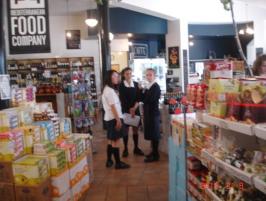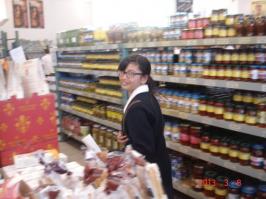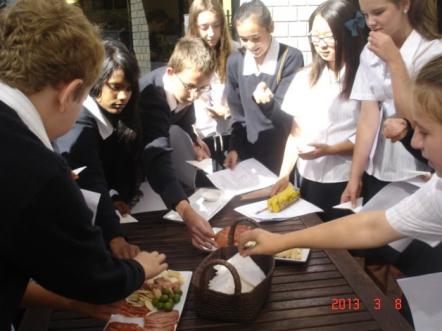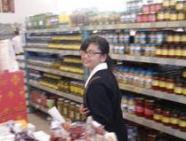Technological knowledge and global food contexts
A successful year 9 food technology programme of learning with a global context was adapted to incorporate the technological products component of the technology learning area. As they explored international foods, the students learnt about the properties of the ingredients they used and how those ingredients could be manipulated.
Riccarton High School teacher Gillian Mandley reviewed her programmes and planned to incorporate more learning from the technological knowledge and nature of technology strands, focusing on the technological products component.
Adapting a programme of learning
In previous years, Gillian had taught a year 9 programme of learning with a community focus – munch around the world. Riccarton High School has a large number of international students and the class worked in groups to develop traditional recipes from different cultures. Gillian says it was impossible to add more teaching to the 10-week (three one-hour lessons per week) programme of learning without dropping something else. She decided to lessen the emphasis on technological practice (given that students would be learning about this component in other technology rotations) and do less teaching around the brief development component.
The unit started with a pre-test on technological literacy to assess students’ prior knowledge (particularly of technological products) and a lesson about food technology, food safety, and hygiene. Gillian put the students into groups of three and gave them a brief to consider: "To produce a healthy recipe for a specific cultural group and to share it with the school community through the school newsletter." The students developed fruit platters and chicken and vegetarian kebabs. While developing their healthy recipes, the students practised cooking skills – weighing and measuring, knife skills, oven use, and reading recipes.
Technological products
The technological products component was introduced when the class arrived to the smell of butter chicken bubbling on the stove. Most of the students were familiar with this dish, and some immediately made comments such as: “It looks a bit thin”. The sauce still needed reducing so Gillian asked what the students thought could be done to thicken it. This opened up a big discussion and to students thinking about ingredients. Gillian then had the students taste the chicken in order to identify the (24) ingredients, suggest what their individual functions were in the recipe, and record their answers on a worksheet.
Performance properties of ingredients used to make butter chicken (Word 2007, 20 KB)
Gillian laid out all the ingredients individually for the students to examine them and their performance properties. Each student was assigned one ingredient and produced a poster for the classroom wall (the word wall) describing the physical and functional characteristics of that ingredient.
Words to learn: Week 4, term 3, word wall (Word 2007, 14 KB)
Gillian says the food sampling activities helped her students to curriculum Levels 1 and 2 understandings, so that she could then them up to Level 4.
“The discussion around the food-tasting activities, and the opportunities to develop the necessary literacy skills (understanding the terminology of the component), helped the students move up the curriculum levels. Producing the word wall helped start this off, and next time we will add to the word wall as the students gain a deeper understanding of ingredients.” She says.
Within the original unit, the students had done sensory evaluation 'at a level'. To get students thinking about the language involved, Gillian had them taste cheese and use a star profile with descriptors to evaluate the samples. The adapted programme of learning involved students in more formal sensory testing, and gave them more to do it.
In another lesson, each group was given a pre-made butter chicken product and heated it up according to the instructions on the packet or jar. They had to check that the product was safe to eat and then set up a sensory evaluation session for the rest of the class. The students recorded their observations on a worksheet and shared their thoughts during a class discussion. “The students looked at the labelling and compared the ingredients. They could taste the differences and observed that some were thicker or thinner. We were starting to look at curriculum level 3 and 4 technological products. Next time, I will try to include some objective testing.”
Exploring international foods

In preparation for the students’ research, Gillian informed the librarians of the cultures the groups were studying, so that they had plenty of books and magazines that were relevant to the programme of learning. Time was also allocated during the library sessions to teach students effective library and internet research skills. The groups looked at the types of food grown and eaten in their chosen culture, and considered the physical and functional characteristics of those foods. In the classroom, they learnt about nutritional guidelines for healthy eating, and tested a variety of foods – exploring the performance properties of the ingredients, and conducting objective and subjective testing.
The class also explored international foods through visiting food markets – Asian, Mediterranean, and Korean. (Each group was assigned a task to help organise the visits.) Students were allowed to select some items of food for Gillian to purchase, as long as it was food that the group hadn't eaten before. Back at school, the students tasted all the different foods and did a sensory analysis of them.

With increased understanding of ingredients and their functions, each group developed a recipe that was representative of one of the cultures in their team. The students presented their food to the class, describing the physical and functional attributes of the main ingredients and the changes to the ingredients during preparation and cooking. The students conducted a sensory evaluation test on each dish. Each group produced a presentation about their recipe and the ingredients. These presentations were put on Moodle.
Success
Examples at the appropriate curriculum level
Although Gillian describes the adapted programme as "still a work in progress", she is pleased with its success. “The students were positive about the programme of learning and enjoyed choosing their own recipes to trial and test. Next time, I will them to include more examples that relate to curriculum level 4 of the technological products when they present their .”

A greater variety of food and materials testing
Gillian also plans to add a greater variety of food testing, including more sensory evaluation and possibly some paired comparison tests. She wants to up the Year 10 programme as well, and have students doing a lot more experimental work. While adapting munch around the world, Gillian also added more testing and trialling of materials to her Year 11 course.
Focus on technological practice
The year after first delivering the adapted programme of learning, Gillian revised the booklet and included a course outline for the students. Other changes made to the workbook include moving the focus from technological practice to technological products and including associated vocabulary. "We have found that students have had lots of teaching around technological practice but have not had any specific teaching for the knowledge and nature strands. This should also help students to be better prepared for year 11 (curriculum level 6) understandings rather than trying to teach levels 1–6 in one year. Butter chicken has been used as the product to teach levels 1–4 of the technological products part of the learning area. Almost all students know this dish and have tried it, which enables them to make more connections."
Gillian says, "It is important to note that the year 9 outline is a guide to help students, but by week 6 each group should have had enough scaffolding to enable them to work independently. This means they plan when they need to use the food room to trial and test their concepts or when they need to use devices to record the evidence of what they are doing. Groups who are well planned and organised get to trial and test more concepts and develop more ideas, but groups who need more scaffolding and guidance can have this too."

